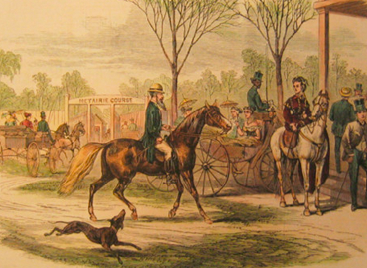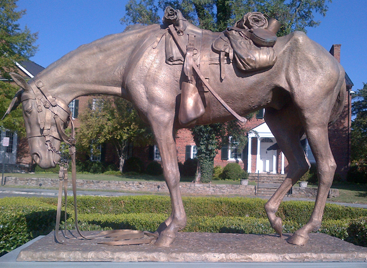The Metairie

The Metairie, that great antebellum track where Lexington ran, fell to a fate embroiled by greed and vindictiveness. Charles T. Howard was the “Lottery King” of Louisiana. He’d spearheaded the Louisiana State Lottery Company for years as its President, much to his financial benefit. His fleet of yachts was just one of his many whimsical hobbies. In late 1870, he added the Jennie Bonnie to his collection, a thirty-six-foot vessel that had notably sailed some 6,000 nautical miles along the Atlantic and Gulf coasts. But aside from providing Howard with cash to live life to its fullest, the lottery business was not one 1870s Louisiana citizens unanimously embraced. Some Louisianans called the lottery “evil.” Bishop Taylor, New Orleans’ reigning cleric, went so far as to castigate the lottery as an “illness and wantonness providing games for the lazy and useless people of the world.” The Daily Picayune wrote that the lottery “corrupts the youth of our city and State…robs honorable toil of its fruit…and saps the very morals of society.” Never mind that poker parlors functioned non-stop on every street corner.
Regardless of its execrable reputation, the Louisiana lottery was big money. One hundred thousand tickets were sold monthly, amounting to $2,000,000. “The monthly drawing featured $1,054,600 in 3,134 prizes ranging from $100 to $300,000.” Back then, lottery tickets were pre-drafted by the Lottery Commission, with numbers arbitrarily assigned. There was no room for playing birth dates, number of children in one’s household, or even the brazen “13.” A person merely offered money for a random ticket and took his chances with whatever numbers appeared thereon. A one-dollar ticket could quadruple just by winning a small prize. And for $1.25, termed a “gig and saddle,” a player could win $2.45 if two out of three numbers on his ticket were drawn. One’s mathematical chances of winning, although not great, were good enough to risk the bet. For one dollar, anyone had a one in 67,525 chance of winning the daily grand prize, $4,275.40.
More significant to Howard, the Lottery owned any ticket that wasn’t sold. “[The Lottery] could and did win prizes in its own drawings,” wrote one historian. On one such occasion for the monthly grand prize of $300,000, the Lottery won! On average, the Lottery would only pay half of every one hundred dollars it took in.
To keep this kind of money flowing, Howard embroiled himself in an ugly matter referred to as the “1870 Levee Bill Bribery.” The Levee Bill called for the Legislature to transfer control of Louisiana’s levee system out of the State Board of Public Works and into a privately held company, the Louisiana Levee Company. The Levee Company then assumed exclusivity to all construction repair contracts to improve the levee system. Usually shoddy and unsupervised work that was high priced. The Picayune wrote extensively of the matter, yet never proffered Howard’s reasoning for becoming involved. Gleaning from articles written on the debacle, Howard may have acted at the behest of Louisiana’s Governor, H.C. Warmoth, who had already rubber-stamped Howard’s much-sought after legislative act granting him a twenty-five-year monopoly of the Louisiana State Lottery Company. Governor Warmoth’s purpose for intervening in the Levee Bill cannot be answered either, other than possibly an agreement for backdoor refunneling of profits from the Levee Company.
Whatever the reason, the Levee Bill became law in 1871. According to a financial evaluation completed six years later, the Levee Bill cost Louisiana $12,245,000, driving that State into debt. Gubernatorial requests or not, Howard was caught openly bribing members of the Louisiana Legislature by paying them $1,000 each to vote favorably for the Levee Bill. His candid response to legislative members who questioned him was, “I only want to make friends in the Legislature.”
That’s how Charles T. Howard conducted business in Louisiana. It’s with little wonder then why Howard was blackballed when, in 1871, he requested membership into the Metairie Race Course Association. Indignant at what he perceived a slight, Howard told the Metairie turfmen,
“You can refuse me admission into your club, but you cannot prevent me from changing your racecourse into a burying ground.”
In 1872, when the Metairie had fallen into the hands of “speculators who cared little for racing,” Howard bought the then struggling race course for $128,000. The Spirit of the Times reported, “The Metairie Association has sold the Metairie Race Course. It will be turned into a cemetery…Among the old turfmen, a general feeling of gloom.”
Richard Ten Broeck’s thoughts on the Metairie’s demise are unknown. Although he was extremely unsentimental by nature, it seems inevitable that he felt sorrow. He was one of the founders of the New Orleans turf, making the Metairie the model for other tracks.
Although Ten Broeck had bowed out of New Orleans years before, Lexington’s records—all on the Metairie–stood in the racing books never to be erased. The memories of seeing the extraordinary horse break Time existed in the minds of those who were there. Those memories were passed down and kept alive. Still, Metairie’s fate was, as Vosburgh wrote, “a source of general regret that a place hallowed by so many glorious memories should have been thus sacrificed.”
April 1872 was the last time a race was ever run over the Metairie. Lexington’s daughter, Annie Bush—bred at Woodburn—won the Great Post Stake after twelve grueling miles. “As the daughter of Lexington was led away, the word FINIS was written into the record of the most renowned of America’s antebellum race courses.”
In July 1873, Howard’s men started tearing the Metairie apart. The Picayune wrote, “The old Metairie Race Course is undergoing the changes incident to its new sphere. The inside fences around the old track have been taken down, and the last brick of what was once the commodious grand stand is now carted away.”
When the Metairie Course closed its gates, the Fair Grounds Race Course opened down the road. The Fair Grounds still operates today. The first race ever run there was the Grand Inaugural Post Stake won by Lexington’s son, Monarchist.
An aerial photograph of the Metairie Cemetery shows the outline of an oval racetrack. The cemetery is laid out in three segments of sparkling white tombs arrayed around three ellipses. On a leisurely afternoon one can visit the graves of Al Copeland–founder of the Popeye’s Fried Chicken franchise, jazz musicians Al Hirt and Louis Prima, jazz vocalist Gia Maione, author Grace King, poet and painter Stan Rice, shipbuilder Andrew J. Higgins, brothel queen Madam Josie Arlington, just about every Louisiana congressman and governor as well as New Orleans’ mayors–one of whom is buried next to Madam Arlington–Major League Baseball player and 1951 Hall of Fame inductee Mel Ott, and one of the Metairie’s most recent inhabitants, Tom Benson, who owned the National Football League’s New Orleans Saints and the National Basketball Association’s New Orleans Pelicans.
Besides the famous people, Metairie is filled with ornate and imposing gothic architecture, a sphinx and pyramid at the tomb of Lucien Brunswig, and at Francis Masich’s tomb, a marbleized white dog shedding a tear. According to a 1982 New Orleans Picayune article, at random times flowers are tied around the dog’s neck along with a card that reads “To a good dog.” Buried in the center of Metairie is Louisiana’s Lottery King, Charles T. Howard. Inside his tomb sits a marbleized figure of an unnamed man holding a finger to his lips as if to hush even more the silence that pervades the grounds.
Despite every intention of Charles Howard to vengefully bring death to a place once exploding with cheer, he ensured Metairie’s infinite existence. The cemetery’s engineer, Benjamin Morgan Harrod, used the track as the basis for his plan, incorporating the actual racetrack into the cemetery’s schematic layout. Grand mosques, double vaulted marbled tombs, and Greek and Classical Revival structures stand in rows facing each other, separated by elliptical roads. Metairie Avenue, the second elliptical road from the center, is the old track where Lexington ran. The dead, by the fact they consecrated the grounds outlining the racetrack, ensure Metairie will always live.


